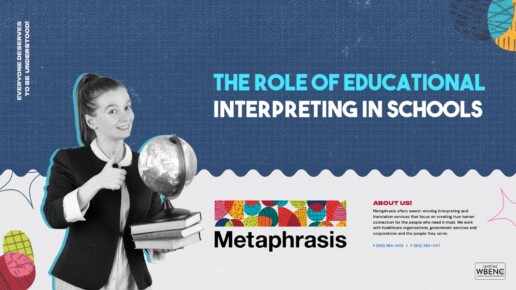The Role of Educational Interpreting in Schools
Introduction
Education is the foundation of a prosperous society, ensuring that every student, regardless of background or ability, has access to knowledge and opportunities. However, language barriers can pose significant challenges for students who are non-native speakers or have hearing impairments. This is where educational interpreting plays a crucial role. By bridging communication gaps, interpreters help students fully engage with their learning environment.
In this blog, we’ll explore the significance of educational interpreting in schools, its impact on students and teachers, the different types of interpreting used, and the challenges faced in this field.
What Is Educational Interpreting?
Educational interpreting refers to the process of facilitating communication between students, teachers, and peers through professional interpreters. These interpreters work in classrooms, extracurricular activities, and school meetings to ensure that all students, including those with limited English proficiency (LEP) or hearing impairments, receive an equitable education.
Key aspects of educational interpreting include:
- Facilitating classroom communication
- Ensuring equal access to learning materials
- Helping students participate in discussions and activities
- Assisting teachers in effective communication with diverse students
Interpreters act as a bridge, ensuring that language differences do not become a barrier to education.
Why Is Educational Interpreting Important?
The role of educational interpreters extends beyond mere language translation. They are instrumental in promoting inclusivity, academic success, and social integration for students who might otherwise struggle to keep up with their peers.
Key Benefits of Educational Interpreting:
- Enhances Learning for Non-Native Speakers
- Students learning English as a second language (ESL) can better understand lessons when they have an interpreter.
- Supports Deaf and Hard-of-Hearing Students
- Sign language interpreters ensure that students with hearing impairments can access lectures, discussions, and school events.
- Encourages Classroom Participation
- When students understand the material, they are more likely to engage in discussions and activities.
- Aids Teachers in Delivering Effective Lessons
- Teachers can focus on teaching without worrying about language barriers, leading to a more inclusive learning environment.
- Fosters Parental Involvement
- Interpreters help parents who are not fluent in the school’s primary language to communicate effectively with teachers and administrators.
Without educational interpreters, many students would struggle to access the education they deserve, potentially affecting their long-term academic success.
Types of Educational Interpreting
There are different methods of interpreting used in schools, depending on students’ needs and the situation.
Sign Language Interpreting
- Used for students who are deaf or hard of hearing.
- Common sign language systems include American Sign Language (ASL) and Signed Exact English (SEE).
- Interpreters convey spoken language into sign language and vice versa.
Spoken Language Interpreting
- Supports students with limited proficiency in the school’s primary language.
- The interpreter translates spoken communication between the teacher and student in real time.
CART (Communication Access Realtime Translation)
- A speech-to-text service used for students who are deaf or hard of hearing.
- The interpreter types out what is being said, and students can read it on a screen.
Consecutive & Simultaneous Interpreting
- Consecutive interpreting: The speaker pauses to allow the interpreter to translate.
- Simultaneous interpreting: The interpreter translates in real time without pauses.
- Used in various classroom settings depending on the lesson’s nature.
Challenges Faced by Educational Interpreters
Despite their essential role, interpreters face several challenges in a school setting.
Maintaining Accuracy & Neutrality
- An interpreter must accurately translate spoken or signed language without adding personal opinions or changing the message.
Understanding Educational Terminology
- Schools use subject-specific vocabulary, which can be difficult to interpret correctly, especially in technical subjects like science and math.
Managing High Workload & Stress
- Interpreting requires high concentration, and interpreters often work under pressure to keep up with fast-paced classroom discussions.
Cultural Sensitivity
- Interpreters must be aware of cultural differences and adapt their communication accordingly to avoid misunderstandings.
Limited Availability of Trained Interpreters
- Many schools face a shortage of qualified educational interpreters, making it difficult to support all students in need.
The Future of Educational Interpreting
As schools become more diverse, the demand for educational interpreters is growing. Several advancements and initiatives are being implemented to improve the field.
Technology & AI in Interpretation
- Speech-to-text software and AI-powered translation tools are increasingly used in classrooms.
- However, human interpreters remain essential because AI tools may lack accuracy and cultural sensitivity.
Increased Training & Certification
- More institutions are offering specialized training programs for educational interpreters to improve quality and accuracy.
Government Policies & Support
- Schools are receiving more funding and legal backing to provide interpreting services, ensuring that every student has access to education.
Conclusion
Educational interpreting is a vital component of inclusive education, ensuring that all students, regardless of language ability or hearing impairments, receive equal opportunities in school. By facilitating clear communication between students, teachers, and parents, interpreters help create a learning environment where everyone can thrive.
As schools continue to diversify, the need for qualified and well-trained educational interpreters will only increase. Investing in better interpretation services, training programs, and technology will be essential in building a truly inclusive educational system.

